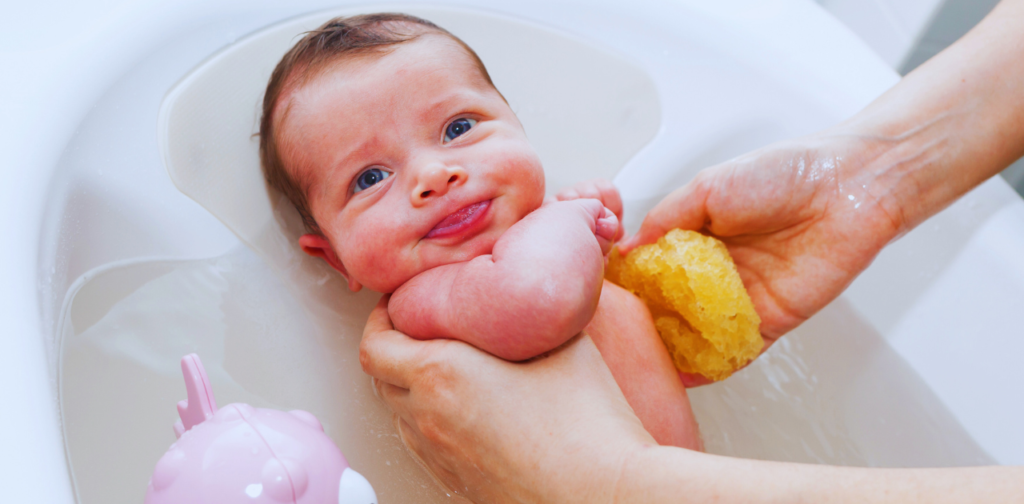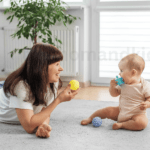Bathing your baby is one of those special bonding moments, but knowing when to make it a daily ritual can be confusing. Many new parents wonder: when is the right time to start bathing a baby every day? In those early months, newborns have delicate, sensitive skin that doesn’t need frequent washing. Too much bathing can sometimes do more harm than good, stripping their skin of natural oils and causing dryness or irritation.
As your baby grows, however, daily baths can become a comforting part of their routine, helping them wind down and sleep better at night. This guide walks you through the key factors to consider when starting daily baths, from understanding your baby’s skin needs to creating a safe and enjoyable bath experience. With a few practical tips, you’ll know precisely when—and how—to make bath time a soothing, healthy habit for your little one.
Understanding Baby’s Bathing Needs

In the early stages of life, a baby’s skin is incredibly delicate and more sensitive than an adult’s. Frequent bathing isn’t necessary and can even be a bit harsh on their skin. Newborns, in particular, don’t get dirty like older kids do. They aren’t playing outside, sweating, or exposed to much dirt, so they only need minimal cleaning.
Sponge baths a few times a week are typically enough for the first few weeks to keep them clean while protecting their natural skin barrier. Bathing too often can strip away these protective oils, leading to dryness or irritation. Instead, focus on gently wiping areas that need regular attention, like the face, neck folds, and diaper area. As your baby grows and moves more, you might gradually increase the frequency, but it’s best to approach daily baths carefully and only when their skin is ready.
Why Babies Don’t Need Daily Baths Initially
In the beginning, babies simply don’t need daily baths. Newborns have sensitive skin that benefits from limited exposure to water and cleansers, which can strip their skin of natural oils. This protective layer helps keep their skin moisturized and shields them from environmental irritants. Bathing too frequently can disrupt this balance, resulting in dryness, irritation, or rashes.
Additionally, newborns don’t sweat or get very dirty, as they aren’t crawling, eating solids, or engaging in activities that would cause them to need frequent cleaning. Instead, quick wipe-downs of the face, neck, and diaper area are usually enough to keep them fresh. Occasional sponge baths help maintain their hygiene without compromising their skin’s health. Waiting until your baby’s skin matures and they become more active allows you to introduce daily baths more comfortably, ensuring their skin stays soft, healthy, and protected in those crucial early months.
When to Start Bathing Newborns
For the first few weeks, newborns don’t need full baths. The ideal approach is to begin with sponge baths, allowing you to gently clean your baby without immersing them in water. The best time to start regular tub baths is typically after the umbilical cord stump falls off and heals, usually around two to four weeks after birth.
Delicate Skin Considerations
A newborn’s skin is extremely delicate and thin, making it more prone to dryness and irritation. Daily baths can disrupt their skin’s natural oils, leading to potential discomfort or skin issues. Limiting baths to a few times a week helps maintain these natural oils, essential for keeping their skin moisturized and protected. As a baby’s skin gradually develops and becomes less sensitive, you can adjust the bathing routine accordingly.
Sponge Baths vs. Tub Baths
Sponge baths are the safest and most recommended method for newborns in the first few weeks. They allow you to clean specific areas, like the face, hands, and diaper, without fully immersing your baby. Once the umbilical cord stump has healed, you can transition to tub baths, which can be more relaxing and offer a bonding experience for you and your baby. Start slowly, ensuring the water is warm and shallow, and always support your baby to keep bath time safe and comfortable.
When to Switch to More Frequent Bathing
Around 2 to 3 months, you can consider increasing your baby’s bath frequency, especially if they enjoy bath time or if it helps them relax before bed. By this age, their skin has typically become more resilient, making it less prone to dryness or irritation from water exposure. Additionally, as babies become more active, they start to sweat and explore their surroundings more, which might lead to a bit more mess!
Many parents find that incorporating a bath into bedtime can signal to the baby that it’s time to wind down and sleep. However, even as you increase bath frequency, you don’t need to make it a daily ritual unless it works well for your baby and their skin stays healthy. Bathing every other day is often a good balance, keeping them clean while preserving natural skin moisture.
Signs Your Baby is Ready for Daily Baths
Deciding when to start bathing your baby daily depends mainly on their skin’s development and activity level. Here are some signs that your baby might be ready for a more frequent bath routine:
- More Active and Mobile: As your baby starts to move around more, especially when they begin tummy time, rolling, or crawling, they’re likely to get dirtier and sweat more. This added activity can signal that they’re ready for regular baths.
- Tolerant Skin: If your baby’s skin shows no signs of dryness, irritation, or sensitivity after baths, they may be ready for daily washing. Babies’ skin typically becomes less delicate around 2-3 months, allowing for more frequent baths without discomfort.
- Establishing a Bedtime Routine: Bathtime can be a soothing part of the bedtime routine, helping babies relax and wind down before sleep. If your baby seems to enjoy baths and finds them calming, adding a daily bath to the evening routine can make bedtime smoother.
- Messy Eaters: Once your baby starts solids, mealtime can get dirty. A quick bath afterward can help keep them fresh and prevent any skin issues caused by leftover food residue.
Benefits of Daily Bathing for Babies
Daily baths can be an excellent addition to your baby’s routine, offering more than just cleanliness. Here are some of the key benefits:
- Relaxation and Better Sleep: Bathing in warm water has a soothing effect that can help babies unwind and prepare for a good night’s sleep. Incorporating a bath into the evening routine often helps babies settle down and signals that bedtime is approaching.
- Skin Care and Hydration: A gentle daily bath helps to cleanse sweat, dirt, and food residues that can accumulate on your baby’s skin. Regular cleansing can also prevent skin issues like rashes, especially around the neck and folds where milk or drool can gather.
- Strengthened Bonding Time: Bath time provides a dedicated opportunity for bonding, allowing you to engage with your baby through eye contact, gentle touch, and soothing words. It can be a particular time for connection that you and your baby look forward to.
- Sensory Development: Daily baths offer a rich sensory experience—babies can feel the water’s warmth, hear the splashes, and enjoy the gentle rhythm of bathing. These sensations stimulate their senses and support cognitive development over time.
- Establishing a Routine: Babies thrive on routines, and daily bathing can help create a consistent pattern, adding predictability and comfort to their day. As they grow, this routine can help babies understand time concepts, such as the difference between day and night.
How to Introduce Daily Baths Safely

Introducing daily baths into your baby’s routine can be a delightful experience for both of you, but it’s essential to do so safely. Here are some tips to help you make bath time enjoyable and secure:
- Choose the Right Time: Aim to bathe your baby when calm and content, such as after a nap or feeding. Avoid bath time if your baby is fussy or tired, which can lead to a negative experience.
- Create a Comfortable Environment: Ensure the bathroom is warm and draft-free to keep your baby comfortable. You should play soft music or use calming scents to create a relaxing atmosphere.
- Use the Right Equipment: Invest in a sturdy baby tub or support seat that securely fits your bathtub. Always use a non-slip mat to prevent any slips and falls. Ensure that all your bathing supplies are within reach before you start so you can always keep one hand on your baby.
- Check the Water Temperature: Always test the water temperature before placing your baby in the tub. The water should feel warm, not hot, ideally around 37°C (98.6°F). A quick way to check is by using your wrist or elbow, as these areas are more sensitive to temperature.
- Supervise at All Times: Never leave your baby unattended in the bath, even for a moment. If you need to grab something, take your baby with you or place them in a safe area, like a crib until you return.
- Use Gentle Products: Choose mild, fragrance-free baby soaps and shampoos to avoid irritating your baby’s sensitive skin. Keep the products minimal, and consider doing a patch test on a small area of their skin if you’re trying a new product.
- Make It Fun: Turn bath time into a playful experience using toys, gentle splashing, or songs. This can help your baby associate baths with fun and relaxation rather than a chore.
How to Introduce Daily Baths Safely
Tips for Creating a Comfortable Environment
Creating a soothing and inviting bath environment is essential for making bath time a positive experience for your baby. Here are some tips to consider:
- Warm the Bathroom: Close windows and doors before bath time to prevent drafts. You might even consider running the heater for a short while to keep the room warm and cozy, ensuring your baby feels comfortable once out of the water.
- Set the Mood with Lighting: Use soft lighting, such as dimmable or nightlights, to create a calming atmosphere. Bright lights can be overstimulating, while softer lighting can help relax your baby.
- Have Supplies Ready: Gather everything you need—towels, washcloths, baby soap, and toys—before starting the bath. This way, you won’t need to leave your baby unattended to fetch something, which can compromise safety.
- Use a Non-Slip Mat: If you’re bathing your baby in a regular tub, ensure a non-slip mat provides traction. This helps prevent slips and makes the bath area safer for both of you.
- Add a Splash of Fun: Incorporate bath toys or floating objects to make bath time engaging. Simple toys can entertain your baby and help them enjoy the experience more.
Ideal Water Temperature and Time of Day
- Water Temperature: The ideal water temperature for a baby’s bath is around 37°C (98.6°F). Always check the water with your wrist or elbow before placing your baby in, as these areas are more heat-sensitive. The water should feel warm but not hot to ensure your baby’s comfort and safety.
- Choosing the Right Time of Day: Bathing your baby in the evening can be particularly beneficial. Many parents find that a warm bath helps soothe their baby and signal that it’s time to wind down for the night. However, observe your baby’s routine and preferences; some babies may prefer baths earlier in the day. The key is establishing a consistent routine that fits well into your family’s schedule.
Choosing Bathing Products for Babies

When selecting bathing products for your baby, choosing the right ones is crucial for protecting their sensitive skin. Here are some guidelines to help you make informed decisions:
- Opt for Gentle Formulations: Look for products specifically designed for babies, as they are formulated to be milder and less irritating. Choose gentle, hypoallergenic options free from harsh chemicals, sulfates, and parabens.
- Fragrance-Free is Best: While some products may be marketed as “baby-scented,” it’s often best to avoid fragrances altogether. Scented products can contain irritants that may lead to allergic reactions or skin sensitivities. Instead, choose fragrance-free options to keep your baby’s skin safe.
- Use Tear-Free Formulas: If you plan to use shampoo and body wash, look for tear-free formulations. These products are designed to be gentle on the eyes and make bath time a more pleasant experience for you and your baby.
- Consider Natural Ingredients: Many parents prefer using natural or organic products from plant-based ingredients. These can be gentler on the skin and may contain beneficial properties like moisturizers. However, always check the ingredient list to ensure there are no allergens.
- Avoid Products with Alcohol: Avoid products containing alcohol, as they can be very drying and irritating to a baby’s delicate skin. Instead, choose moisturizing cleansers that help keep the skin hydrated.
- Test New Products Carefully: Before introducing a new bathing product, perform a patch test on a small area of your baby’s skin. This helps you identify any potential reactions before applying it more broadly.
- Keep It Simple: Babies don’t need an extensive array of products. A gentle soap and a mild shampoo are usually sufficient for bath time. As your baby grows, you can gradually introduce more products based on their needs.
How Long to Keep Daily Bathing Routine
Establishing a daily bathing routine for your baby can be beneficial, but it’s essential to remain flexible and adapt as your child grows. Here are some considerations for how long to maintain this practice:
- Assess Your Baby’s Skin Needs: Monitor your baby’s skin condition closely. If your baby’s skin remains healthy and well-hydrated after daily baths, you can continue this routine. However, if you notice signs of dryness or irritation, consider reducing the frequency to every other day or a few times a week to allow your baby’s skin to retain more moisture.
- Developmental Changes: Babies’ bathing needs may change as they grow and become toddlers. For example, once they start eating solids and become more mobile, they might require more frequent baths to keep clean. Conversely, if your toddler is less messy or enjoys playing in the dirt outside, you may find that a bath every few days suffices.
- Family Schedule: Consider your family’s daily routine and lifestyle. If daily baths fit well into your schedule and your baby enjoys them, they can be a lovely bonding experience. However, if they become a chore or a source of stress, it might be time to reassess and adjust the frequency.
- Personal Preference: Each family is different, and personal preference plays a significant role in maintaining a bathing routine. If daily baths feel beneficial for both you and your baby, continue with them. However, if they feel overwhelming, it’s perfectly fine to scale back.
- Transitioning to Independence: As your child grows and gains independence, they may become more involved in their bathing routine. You can gradually shift the responsibility of bathing to them, transitioning to showers or baths that require less parental involvement.
Potential Risks of Over-Bathing
While regular bathing can benefit babies, over-bathing can lead to several issues that may affect their skin health and overall comfort. Here are some potential risks associated with excessive bathing:
- Dry Skin: Babies have delicate, naturally moist skin. Frequent bathing, especially in hot water or using harsh soaps, can strip away the skin’s natural oils, resulting in dryness, flakiness, and irritation, leaving the skin feeling rough and uncomfortable.
- Skin Irritation: Overbathing can lead to irritation and conditions such as eczema. Babies with sensitive skin are particularly prone to rashes and redness, which can be exacerbated by frequent exposure to water and cleansers.
- Allergic Reactions: Bath products used too frequently may increase the likelihood of allergic reactions. Some soaps and shampoos contain fragrances or chemicals that can irritate sensitive skin, leading to redness, itching, or rashes.
- Increased Risk of Infections: When the skin barrier is compromised due to over-bathing, it may be more susceptible to infections. Open skin or irritated patches can allow bacteria or fungi to enter, potentially leading to skin infections or other complications.
- Unpleasant Associations: If bath time becomes too frequent or stressful, your baby may start to develop a negative association with bathing. This could result in crying or resistance during bath time, making it a more challenging experience for both parent and child.
- Environmental Concerns: Frequent bathing uses more water and resources, which can impact the environment. Reducing bath frequency can be a simple way to conserve water and promote sustainability.
Tips for Bathing a Baby Safely
Bathing your baby can be a joyful bonding experience, but safety should always come first. Here are some essential tips to ensure bath time is safe and enjoyable for both you and your little one:
- Never Leave Your Baby Unattended: Always keep a hand on your baby while in the bath. If you need to leave the room, take your baby with you or place them in a safe area, like a crib.
- Prepare the Area: Before starting the bath, gather all the necessary supplies, including soap, towels, and washcloths. Everything within reach ensures you won’t need to leave your baby unattended.
- Use a Baby Bathing Seat or Tub: If you’re using a standard bathtub, consider a baby bathing seat or a specialized baby tub designed for safety. These products provide support and help prevent slips.
- Check the Water Temperature: Always test the water temperature before placing your baby in the tub. It should be comfortably warm, around 37°C (98.6°F). Use your wrist or elbow to check the temperature, as these areas are more sensitive.
- Use Non-Slip Mats: If bathing in a regular tub, place a non-slip mat on the bottom to reduce the risk of slipping. This provides extra stability for you and your baby during bath time.
- Keep Water Level Shallow: For newborns and young babies, keep the water level shallow—a few inches deep is sufficient. This reduces the risk of accidental submersion and helps you maintain better control.
- Avoid Distracting Items: Remove any distractions, such as phones or toys, that could divert your attention. Stay focused on your baby during bath time to ensure their safety.
- Be Gentle: Use a soft washcloth to clean your baby’s skin, and avoid scrubbing too hard. Babies have delicate skin, so gentle handling is crucial in preventing irritation.
- Monitor for Temperature Changes: Recheck the water temperature if your baby starts to shiver or seems uncomfortable. Babies can lose body heat quickly, so keeping them warm throughout the bath is essential.
- Wrap Up Quickly: Wrap your baby in a warm towel to keep them cozy once bath time is over. Dry them gently and thoroughly, particularly to skin folds where moisture can linger.
Adjusting to Seasonal Changes
As seasons change, so do your baby’s needs during bath time. Here’s how to adjust your bathing routine to accommodate seasonal variations:
- Temperature Control: In colder months, ensure the bathroom is warm and comfortable before bath time. You might want to run a space heater briefly to keep drafts at bay. In warmer months, ensure the bathwater is comfortably warm but not too hot, as babies can overheat quickly.
- Skin Care Considerations: Changes in humidity and temperature can affect your baby’s skin. In winter, dry air can lead to dry, chapped skin. Consider using a gentle moisturizer after baths to help lock in moisture. In summer, increased heat and sweat can necessitate more frequent bathing to keep your baby clean and comfortable.
- Timing of Baths: During hotter months, consider bathing your baby in the evening when it’s cooler, which can help them relax before bed. In cooler months, you might want to wash your baby during the day when they are more alert and playful.
- Choosing the Right Products: Use more hydrating soaps and moisturizers in winter to combat dryness. In summer, you might want lighter formulas that cleanse without adding heavy moisturizers, especially if your baby tends to sweat more.
- Dressing for the Season: Dress your baby appropriately for the weather after baths. In winter, use warm towels and cozy pajamas, while in summer, light, breathable fabrics will keep them comfortable.
- Adapting Bath Toys: Seasonal changes can also affect the types of toys you use. Consider using floating toys and water-safe items in summer to enhance bath time’s fun. In winter, you might want to incorporate soft, plush bath toys that are cozy and comforting.
- Hydration: Ensure your baby stays well-hydrated throughout the year. Babies may need extra fluids in hot weather, which can help with skin health. Keeping the room humidified in cold months can also help combat dry air.
Conclusion
Bathing your baby is more than just a routine—it’s an opportunity for bonding, comfort, and care. As a new parent, understanding when and how to introduce daily baths and adjusting your approach based on your baby’s needs and seasonal changes is essential for promoting healthy skin and creating a positive experience. Remember to prioritize safety by following best practices, choosing gentle products, and being attentive to your baby’s responses. With patience and observation, you can establish a bathing routine that works for you and your little one, ensuring that bath time becomes a cherished part of your daily life.
FAQs
- How often should I bathe my newborn?
Most experts recommend bathing newborns about two to three times a week until their umbilical cord stump falls off and heals. After that, you can gradually introduce more frequent baths based on your baby’s skin condition and lifestyle.
- What is the best time of day to bathe my baby?
The best time to wash your baby often depends on their routine. Many parents prefer evening baths to help relax their baby before bedtime, but you can also choose a time when your baby is alert and happy.
- Can I use adult bath products on my baby?
It’s best to avoid adult bath products, as they may contain fragrances and harsh chemicals that can irritate your baby’s sensitive skin. Instead, choose gentle, baby-specific products that are formulated for their needs.
- What should I do if my baby dislikes bath time?
If your baby dislikes baths, try changing the environment, using warmer water, or incorporating fun toys. Sometimes, a different time of day or a more relaxed approach can make bath time more enjoyable.
- How can I tell if my baby’s skin is becoming too dry?
Signs of dry skin include flakiness, redness, and irritation. If you notice these symptoms, consider reducing the frequency of baths, using a humidifier, and applying a gentle moisturizer after bathing.
















